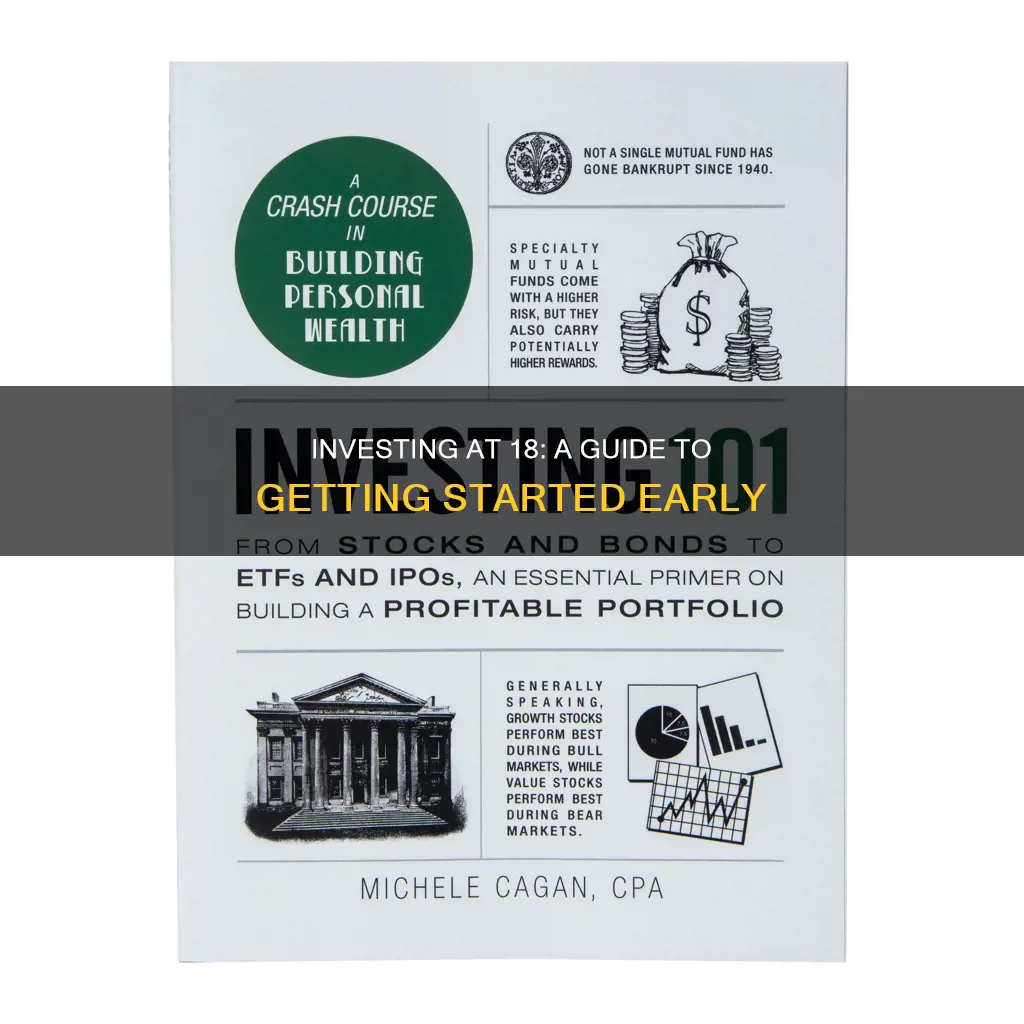
Investing as a teenager is a great way to build wealth over time and set yourself up for a secure financial future. While it may seem daunting at first, there are several steps you can take to get started on your investment journey. Here are the key things you should know about investing at 18:
- Gaining Basic Knowledge: Start by educating yourself about the basics of investing, including different investment options, risk factors, and how the financial markets work. Understanding these fundamentals will enable you to make informed decisions.
- Setting Financial Goals: Clearly define your financial objectives, such as saving for a future home, education, or long-term wealth accumulation. Your goals will guide your investment strategy and help you determine the right types of investments.
- Understanding Risk and Diversification: Recognize that investing carries risks, and the potential for higher returns often comes with higher risk. To mitigate risk, it's essential to diversify your portfolio by spreading your investments across various asset classes, such as stocks, bonds, and real estate.
- Taking Advantage of Time: Time is a powerful factor in investing. The earlier you start, the more time your investments have to grow due to the compounding effect. This means that your returns generate additional returns over time, leading to significant growth.
- Choosing the Right Accounts: If you're 18 or older, you can open an online brokerage account independently. Otherwise, you'll need help from a parent or guardian, who can either open a brokerage account for you or set up a custodial account.
- Practicing with Dummy Portfolios: Before diving into the market with real money, consider experimenting with dummy or mock portfolios. Several websites offer stock market games that allow you to create hypothetical portfolios and compete with others, providing a risk-free way to learn.
- Staying Informed and Adjusting: Keep yourself updated on market trends, economic developments, and changes in your financial situation. Be patient and disciplined, and remember that investing is often a long-term commitment. Adjust your investment strategy as needed based on your evolving goals and market conditions.
- Seeking Professional Advice: If you're unsure or have complex questions, consider consulting a financial advisor. They can provide personalized advice based on your unique circumstances and goals.
Remember, investing carries risks, and there are no guarantees of profits. Always conduct thorough research and understand the potential risks and rewards before making any investment decisions.
| Characteristics | Values |
|---|---|
| Age to open a brokerage account | 18 |
| Investment options for under 18s | Custodial account, joint account |
| Benefits of investing as a teenager | Time in the market, higher returns than savings, cushion against inflation, creates good financial habits, higher risk tolerance |
| Investment account options | Brokerage account, custodial account, Roth IRA, 529 plan, high-yield savings account |
| Investment options | Stocks, bonds, mutual funds, exchange-traded funds (ETFs), index funds, certificates of deposit (CDs), savings accounts, robo-advisors, fractional shares |
| Investment approach | Active or passive |
| Investment research | Company annual reports, financial data, stock symbols, dummy portfolios |
| Investment selection criteria | Risk tolerance, investment goals, tax advantages, diversification, fees |
| Investment advice | Consult a financial advisor, enrol in a course, use investment apps |
What You'll Learn

Learn the basics of investing
Before you start investing, it's important to understand the basics. This includes learning about different types of investments, such as stocks, bonds, mutual funds, and exchange-traded funds (ETFs). It also means understanding key investing concepts like risk tolerance, diversification, and compounding. There are many resources available to help you learn, from books and online courses to investment games and financial news sites. Here are some key basics to get you started:
- Risk tolerance: This refers to your ability and willingness to endure fluctuations in the value of your investments. Generally, young investors like yourself can afford to take on more risk because they have a longer investment horizon.
- Diversification: Diversification involves spreading your investments across different asset classes, such as stocks, bonds, real estate, etc. This helps to reduce risk and enhance the potential for long-term returns.
- Compounding: Compounding is what makes investing early so powerful. It refers to the effect of reinvesting your earnings, which then also earn interest. The longer you allow an investment to compound, the more valuable it becomes.
Online resources to learn about investing:
- Investopedia: This website covers both beginning and advanced investing topics and has a comprehensive dictionary of investment terms.
- Investor.gov: Run by the Securities and Exchange Commission (SEC), this site provides investor education for teens covering stocks, ETFs, cryptocurrency, and other investments.
- Wall Street Survivor: Along with running a stock market trading game, this website also has an education section with lessons about the stock market.
- How the Market Works: This site also runs a stock market game and provides educational content on investing.
- Andrei Jikh (YouTube Channel): This channel teaches basic investing and economic concepts for beginners.
- TeenBusiness (YouTube Channel): A channel dedicated to the teen investor and entrepreneur.
Books to learn about investing:
- The Single Best Investment by Lowell Miller: This book provides criteria for choosing good dividend-paying stocks.
- Investing in REITs by Ralph Block: This book provides an understanding of real estate investment trusts.
Identify appropriate investments for teens
As a teen investor, you can explore a range of investment options, from stocks to exchange-traded funds (ETFs) to low-risk assets such as treasury bonds. Here are some ideas to get you started:
- Stocks of companies you're familiar with: Invest in businesses where your relatives work, companies discussed in business publications like the Wall Street Journal, or brands that you and your friends use and love.
- Exchange-Traded Funds (ETFs): ETFs are a less risky option than investing in individual stocks. They are a diversified group of companies that trade like stocks but are managed by professional fund managers. Look for ETFs based on broad market indexes like the S&P 500 or the NASDAQ.
- U.S. Savings Bonds: These are low-risk, low-return investments where you essentially loan money to the U.S. government.
Learn about companies and financial data
Before investing in a company, it's important to understand its business and financial performance. Here are some steps to follow:
- Read the company's annual report or "10-K" filing, which provides detailed information about the company's operations, financial data, and future plans.
- Use financial websites like Yahoo!Finance to get detailed financial information and performance measures for any company.
- Familiarize yourself with the company's financial statements to assess its financial health and flexibility to survive economic downturns.
Experiment with mock portfolios
Before diving into investing with real money, you can gain experience and build confidence by creating mock portfolios. There are websites that allow you to set up stock market games where you can compete with friends to see who can create the most profitable hypothetical portfolio. This is a great way to learn and make mistakes without risking any actual money.
A Beginner's Guide to Silver ETF Investing in India
You may want to see also

Understand risk tolerance and diversification
Understanding your risk tolerance and knowing how to diversify your investments is key to investing.
Risk Tolerance
Risk tolerance refers to the degree of variability in investment returns that you are willing to withstand. It is a measure of your comfort with the market’s ups and downs, including the potential for loss. It is subjective and varies from person to person.
When assessing your risk tolerance, consider the following factors:
- Investment objectives: Are you investing for significant growth, or is your priority the preservation of capital? The former will involve higher risk, while the latter will involve lower risk but may not result in the desired growth or income.
- Investment time horizon: If you are investing for the long term, you can generally afford to take on more risk, as you have more time to make up for any losses. Conversely, if your investment timeline is short, you may want to consider less risky investments to avoid a significant decrease in your account value.
- Reliance upon the invested funds: Are you dependent on this money for essential expenses, either now or in the future? If so, you may want to opt for less risky investments.
- Personality: Are you generally a cautious person or a risk-taker? If the idea of losing money makes you uncomfortable, you may want to avoid high-risk investments.
Diversification
Diversification is a strategy that involves spreading your investments across different asset classes, such as stocks, bonds, real estate, and cash equivalents. By diversifying your portfolio, you can reduce the impact of any single investment's poor performance and lower your overall risk.
- Balanced funds: These funds typically hold a mix of stocks and bonds, providing both growth and income.
- Mutual funds and exchange-traded funds (ETFs): These can be tailored to various risk levels and can provide a mix of equities and fixed-income securities.
- Dividend-paying stocks: Stocks that pay regular dividends can offer both income and growth potential and tend to be less volatile than non-dividend-paying stocks.
- Alternative investments: For aggressive investors, alternative investments such as hedge funds, private equity, and commodities can provide diversification and high returns, but they are often more complex and less liquid.
Remember, your risk tolerance and investment strategy should be based on your personal circumstances, goals, and comfort level with risk. It's important to make informed decisions and regularly review and adjust your portfolio as needed.
Transferring Mom's Investment Portfolio After Her Death
You may want to see also

Open a brokerage account
Opening a brokerage account is a crucial step in starting your investment journey. A brokerage account is a type of account that allows you to buy and sell various investment assets, such as stocks, bonds, mutual funds, and exchange-traded funds (ETFs). While the specific rules may vary depending on your location, in most states, you need to be at least 18 years old to open your own brokerage account. Here's a guide to help you navigate the process:
Choose a Brokerage Firm
Select a reputable brokerage firm that offers the investment options you're interested in. Compare different firms by considering factors such as fees, investment choices, customer service, and educational resources. Some popular options include Charles Schwab, Fidelity, and Vanguard.
Gather the Required Documents
To open a brokerage account, you'll typically need to provide personal information and documentation. This includes your full name, date of birth, contact information, Social Security number, and government-issued identification. Have these documents ready to streamline the account opening process.
Understand Account Types and Features
Brokerage accounts can vary in terms of features and restrictions. Some accounts may offer certain benefits, such as no minimum deposit requirements, no account fees, or no commissions on specific trades. Additionally, look for accounts that allow fractional share investing, enabling you to invest in small amounts in reputable companies with high stock prices.
Complete the Account Opening Process
Once you've chosen a brokerage firm and gathered the necessary documents, follow the steps provided by the brokerage firm to open your account. This usually involves filling out an application form and agreeing to the terms and conditions. The process can often be completed online and typically takes less than 15 minutes.
Explore the Platform and Start Investing
After opening your brokerage account, take some time to familiarize yourself with the platform and its features. Many brokerage platforms offer educational resources and tools to help you make informed investment decisions. Once you're comfortable with the platform, you can start investing by transferring funds into your account and making your first trades. Remember to consider your investment goals, risk tolerance, and diversification to build a well-rounded portfolio.
Opening a brokerage account is a significant step toward taking control of your financial future. By following these steps, you'll be well on your way to becoming a savvy investor, making informed decisions, and growing your wealth over time.
Key Elements of a Successful Private Equity Investment Memo
You may want to see also

Set investment goals
Setting investment goals is a crucial step in achieving financial success and security. Here are some detailed instructions and considerations to help you establish clear and effective investment goals:
Identify Your Goals
Think about what you want to achieve with your investments. Are you saving for a down payment on a house, funding your education, or building a retirement nest egg? Clearly defining your goals will guide your investment strategy and help you make informed decisions.
Prioritize Your Goals
Not all goals are equally important, and some may be more time-sensitive than others. Prioritize your goals based on their significance to you and the timeframe in which you want to achieve them. For example, saving for a house down payment in the next few years is a short-term goal, while saving for retirement is a long-term goal.
Make Your Goals SMART
Use the SMART framework to set effective goals. This means making your goals Specific, Measurable, Achievable, Relevant, and Time-based. For example, a SMART goal would be to save $20,000 for a house down payment in the next three years, rather than just saying you want to save for a house someday.
Group Your Goals by Time Horizon
Categorize your goals into short-term, medium-term, and long-term. This will help you select the appropriate investment strategies for each goal. Short-term goals are those you want to achieve in the next few years, medium-term goals might be achieved in 3-5 years, and long-term goals are those that are more than five years away.
Choose the Right Investments for Each Goal
The type of investments you choose will depend on your time horizon and risk tolerance. For short-term goals, focus on low-risk investments like money-market funds and high-yield savings accounts. For medium-term goals, you may be able to take on slightly more risk, such as investing in high-quality stocks or dividend-paying stocks. For long-term goals like retirement, stocks are usually the best option as part of a diversified portfolio.
Regularly Review and Adjust Your Goals
Investment goals are not set in stone. Life changes, and your goals may need to change with them. Review your investment goals periodically to ensure they still align with your priorities and make adjustments as needed. This includes adjusting your investment strategies as short and medium-term goals become long-term goals, and vice versa.
Visualizing Your Investment Portfolio: A Graphical Guide
You may want to see also

Choose your investments
Once you have a brokerage account, you can start selecting your investments. Many experts recommend starting with stocks of companies you’re familiar with, and gradually diversifying your investments over time. You could also consider purchasing some of the top index funds, which offer immediate diversification. This way, you don’t have to worry about selecting the “perfect” stock.
Start with small amounts until you become comfortable with the process, and remember to regularly review and adjust your portfolio as needed.
If you’re unsure about where to start, consider consulting with a financial advisor to get personalized advice based on your unique circumstances and goals.
- Stocks: When you buy a stock, you take over a small share of ownership, or equity, in a publicly traded company. Stocks can earn you money in two ways. Many companies make payments known as dividends to their shareholders. Stock prices also fluctuate based on the market’s determination of the company’s value, and if the price of your stock goes up, you can sell it for a profit.
- Mutual funds and exchange-traded funds (ETFs): Mutual funds and ETFs are funds that invest in multiple stocks and other types of assets. ETFs are designed to track a specific market index, sector, or other assets and are available to trade on the stock market. Funds offer built-in diversification, as investors automatically own a variety of assets, reducing the risk of losing their investment completely.
- Bonds: Instead of equity, or ownership in a company, bonds are a type of debt instrument. When you buy a bond, you are essentially making a loan to the bond issuer, who agrees to pay back the principal amount borrowed along with interest payments. Bond issuers include governments as well as corporations. Bonds are considered fixed-income investments and are particularly useful for investors looking to generate a regular income. However, they offer lower return potential, making them less suitable for young investors seeking long-term growth.
- Certificates of deposit (CDs): CDs are similar to savings accounts, but they offer a higher interest rate in exchange for agreeing to leave your money in the account for a fixed period. CDs are more conservative than stocks or bonds, with a more moderate risk profile but lower return potential.
Becoming an Investment Manager: UK Pathways and Steps
You may want to see also
Frequently asked questions
It's important to educate yourself about different investment options, risk factors, and the basics of financial markets. You should also set clear financial goals and consider any tax implications.
You could start with low-risk investments such as savings accounts, certificates of deposit (CDs), or low-cost index funds. You could also consider investing in stocks, bonds, exchange-traded funds (ETFs), or mutual funds.
If you're under 18, you'll need help from a parent or guardian. They can either open a brokerage account for you or set up a custodial account, which allows them to manage the investments on your behalf until you reach legal age.
It's important to understand the risk vs. reward of different investments. Generally, the higher the potential return, the higher the risk. You should also consider diversifying your investments across different asset classes to reduce risk.
Yes, there are many investment apps and robo-advisors designed for beginners. These can guide you in making investment decisions and often have low fees. You can also use tools like Yahoo Finance to build a trial portfolio and track its performance.







